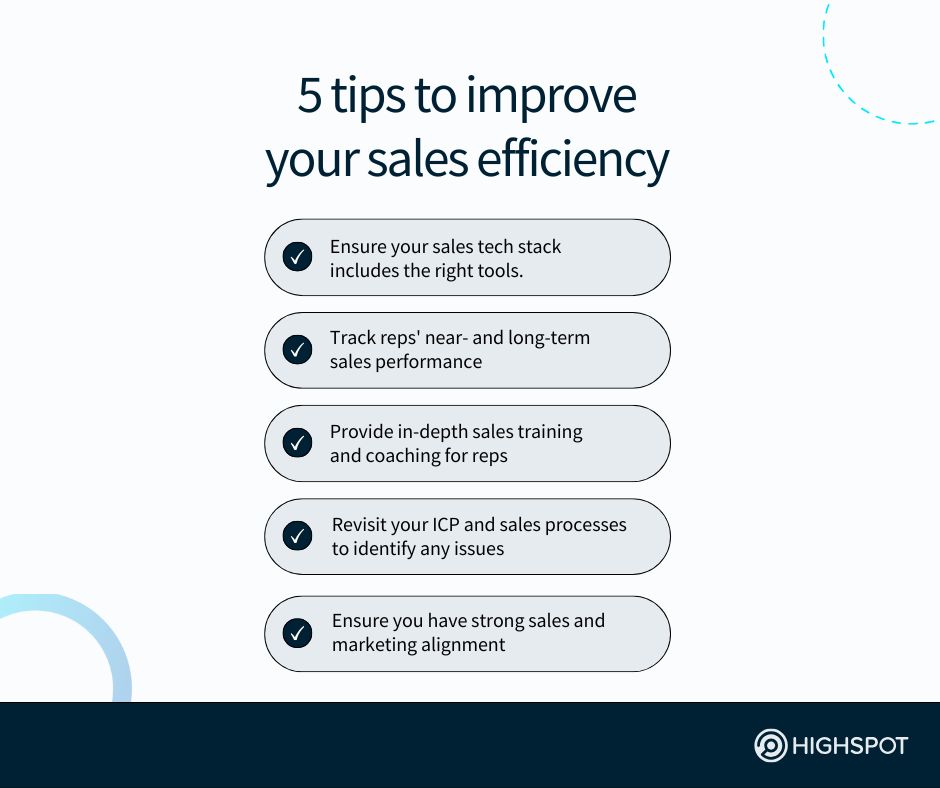Key Takeaways
- A ‘good’ or ‘bad’ sales efficiency ratio can make or break your business. Constant analysis of your reps’ sales performance can identify both their strengths and areas for improvement.
- Your go-to-market (GTM) tech stack and the workflows implemented around your GTM tools—including your sales enablement platform—play a pivotal role in increasing sales efficiency.
- Actionable insights from your GTM solutions can help your business make continual progress with not just revenue growth, but also sales team productivity, performance, and morale.
Go-to-market leaders in sales, marketing, revenue operations, and enablement know sales efficiency isn’t just a core business metric—it’s the North Star guiding their entire GTM strategies.
A consistently high sales efficiency ratio translates directly into greater profitability, more-predictable growth, and the agility to act on and seize market opportunities that emerge.
Yet, while the importance of sales efficiency is widely acknowledged among GTM teams—particularly enterprise ones—few consistently adopt a proactive, structured approach to improve it.
Too often, efforts to increase sales efficiency are sporadic, reactive, and uncoordinated.
What’s more, they usually lack clear visibility into what’s genuinely driving success (a high closed-won rate for high-value accounts with the potential for expansion down the line) or failure (lengthy sales cycles that produce few deals that truly move the needle).
That makes a collaborative, aligned approach to constantly improve sales efficiency critical.
Watch this video featuring the Highspot team to learn how strong communication across your go-to-market function can improve sales and marketing efficiency and productivity.
What is sales efficiency?
Sales efficiency is a key performance indicator (KPI) that measures the effectiveness with which a company’s sales and marketing teams generate revenue.
Sales efficiency is calculated by comparing the incremental annual recurring revenue (ARR) gained from new customers and upsells against the total sales and marketing expenses incurred over a defined period, ultimately revealing how efficiently resources are converted into growth.
In simpler terms, sales efficiency means how well your organization uses its budget to drive high and sustainable revenue growth. It goes beyond merely tracking revenue.
Rather, it’s about getting granular insights into how wisely and effectively your GTM team uses the resources at its disposal to collectively capture new customers and retain existing ones.
Customer acquisition cost vs customer lifetime value
Understanding your company’s sales efficiency involves evaluating several key metrics—notably customer acquisition cost (CAC) and customer lifetime value (CLV):
- The CAC metric represents the total expense incurred to acquire a new customer, including marketing campaigns, sales personnel, and associated administrative costs.
- By contrast, CLV measures the total expected revenue generated by a single customer throughout their relationship with your business.
- A healthy ratio between CAC and CLV signifies robust sales efficiency, indicating your business effectively capitalizes on each dollar invested in customer acquisition.
One particularly useful metric is sales efficiency ratio, which highlights how your sales and marketing efforts generate revenue.
A high sales efficiency ratio means your business efficiently uses fewer resources to acquire each new customer or to grow the value of existing customers, directly improving profitability and growth potential.
It’s important to differentiate between gross sales efficiency and net sales efficiency. Both are crucial metrics that reflect your company’s sales investment, but they focus on slightly different aspects:
| Net Sales Efficiency | Gross Sales Efficiency |
|---|---|
| Includes all costs associated with customer acquisition, including upselling and expansions | Focuses solely on new customer acquisition, excluding expansions or upsells |
| Reflects overall efficiency, including the growth of existing accounts | Highlights the effectiveness of strategies targeting brand-new customers |
| Provides a broader view of long-term revenue health and efficiency | Useful for assessing short-term customer acquisition strategies and initiatives |
Sales managers, directors, and VPs should routinely track both metrics, comparing them against industry benchmarks to identify strengths and weaknesses within their sales processes.
For instance, a low gross sales efficiency could indicate problems with attracting new customers, whereas a weak net sales efficiency might suggest inadequate strategies for customer retention or upselling.
Moreover, improving sales effectiveness—the ability of your sales team to close deals and maximize customer value—is directly tied to enhanced sales efficiency.
Sales and marketing alignment
To align sales processes more effectively with overarching business goals and initiatives, GTM leaders must invest in comprehensive training, implement cohesive communication strategies, and targeted marketing campaigns and programs geared toward potentially high-CLV buyers and accounts.
When sales and marketing teams work closely together, leveraging shared goals and data-driven insights, organizations can reduce wasteful spending, optimize the use of fewer resources, and significantly boost both gross and net sales efficiency.
Go-to-market teams can only realize this sales efficiency improvement, though, with the right technology stack—one with not only a best-in-class CRM like Salesforce at the center, but a unified sales enablement platform as well.
Common sales efficiency challenges
Some of the common challenges just about every GTM team (likely even yours) faces today, when it comes to boosting their sales efficiency, includes:
- Disconnected tools and processes: Fragmented sales tech stacks and disjointed systems leave sellers toggling between platforms, wasting valuable selling time, limiting productivity, and leading to poor sales rep performance.
- Lack of in-depth, actionable insights: Without clear, timely insights from deal and customer data, sales team performance stumbles, as they fail to identify which sales behaviors and strategies actually deliver results. This makes it nearly impossible for them to replicate successes or eliminate inefficiencies.
- Inconsistent adoption and execution: Initiatives designed to boost sales rep efficiency—like those around sales rep training and coaching— often falter because of erratic execution and low adoption, diluting their potential impact and return on investment.
The urgency to address these issues (among others) has never been greater for GTM teams.
As your team navigates tightening budgets (every dollar spent today is more closely watched than ever, as you know), rising customer expectations, and increasing competition, the difference between closing more deals and stagnating often comes down to growing your sales efficiency ratio.
The question, then, is, “Are your current sales efforts positively impacting your company’s sales efficiency, or is there more that could—and should—be done to sign more high-paying customers and drive more revenue?”
How to measure your sales efficiency ratio
You recognize sales efficiency is a business-critical KPI, but it’s still worth breaking down the standard sales efficiency formula and exploring what your efficiency data reveals about your company’s sales performance from a big-picture perspective.
Understanding how to calculate sales efficiency correctly and interpreting and taking action on those results can transform your sales operations, guiding your GTM leadership decisions to boost overall performance in the near term (tactical sales process adjustments by reps and marketing-campaign modifications) and long term (more-strategic and structural changes).
To calculate sales efficiency, use the following, standard sales efficiency formula:
Sales efficiency = sales revenue generated / sales and marketing expenses
When you measure sales efficiency by time period, this simple calculation provides immediate clarity on how effectively your sales team converts spending into revenue. Tracking sales efficiency regularly allows you to diagnose issues early, refine your strategies, and optimize your sales efforts.
Here’s a quick reference table to understand what your sales efficiency ratio might indicate:
| Weak Sales Efficiency Ratio (Less than 1) | Decent Sales Efficiency Ratio (Between 1 and 3) | Strong Sales Efficiency Ratio (Greater than 3) |
|---|---|---|
| A low sales efficiency ratio signifies that your sales and marketing costs exceed the revenue generated. Your sales team may need improvements in effectiveness or cost management. | This ratio suggests a reasonable balance between your investment in sales and marketing and the revenue generated. However, there’s room for optimization and improved strategies. | A good sales efficiency ratio shows highly efficient sales teams effectively converting investment into substantial revenue. Maintain and replicate these successful practices. |
When tracking sales efficiency, it’s crucial to dive deeper into related sales efficiency metrics like sales cycle length, win rate, rep productivity, and sales and marketing expenses ratio can pinpoint specific areas of strength and weakness tied to sales productivity.
Put another way: This regular analysis equips your GTM team with a deeper understanding of operational areas that require attention (think poor time management, late follow-up with engaged leads, failure to unearth prospect pain points quickly on discovery calls, and the like).
In turn, this enables you to direct the necessary resources where they’re most needed most to more intelligently and quickly onboard and upskill reps to boost their performance.

5 tips to improve your sales efficiency
Here are some best practices you and other GTM leaders at your company can follow to steadily improve your sales efficiency ratio, help your reps consistently meet quotas and optimize their day-to-day work, and better contribute to tangible business growth.
Ensure your sales tech stack includes the right tools
The right tech empowers your sales team to operate like a well-oiled machine, directly impacting your sales efficiency metrics and overall sales excellence. Consider the impact a unified sales enablement platform leveraged by sales, marketing, and enablement can have.
A purpose-built sales enablement solution like Highspot offers more than just tools—it brings together intuitive AI analytics and a best-in-class content management system to inform and improve organizations’ sales and marketing efforts.
With personalized guidance, automated training and coaching, and actionable insights, it can quickly level-up your GTM team’s sales efficiency.
Onboarding our platform to boost sales enablement ROI and augment its sales content strategy helps ODP Business Solutions make their reps more productive and give reps crucial time back in their day, allowing them focus on lead nurturing and deal conversion, not admin tasks.
“It’s a huge improvement in efficiencies, which frees up time to let our sellers do what they’re paid to do, which is engage with our customers, bring the value of a partnership between our organizations, and drive profitability and revenue,” ODP Business Solution Lead Growth Strategy Consultant Reynaldo Espinosa recently shared on Highspot’s Win Win podcast.
Track reps’ near- and long-term sales performance
Speaking of analytics, consistently monitoring both near- and long-term sales results (closed-won, closed-lost, and no-decision) can help you quickly ID and address potential issues.
Use detailed sales analytics from the above software (and ‘bonus’ tech like sales intelligence tools that allow for more intricate sales-process analysis) to track KPIs tied to sales efficiency.
By doing so, you can use insights tied to areas like cold sales outreach and utilization of sales enablement content like digital rooms to see what is and isn’t working for your sales team.
Provide in-depth sales training and coaching for reps
Investing in ongoing training and personalized coaching around things like value selling and objection-handling ensures your sales reps have the skills and knowledge necessary to excel.
Regular training programs and courses can keep your team updated with the latest sales techniques, updates to your sales methodology, and information on new product launches.
Personalized coaching with an AI-powered selling tool like Highspot further reinforces good sales skills, addresses reps’ weaknesses, and enhances your team’s sales effectiveness.
Sales stands on the brink of a profound transformation” due to generative AI’s emergence, McKinsey & Co. analysts recently wrote. “The fundamental role of the seller may not change, but the power of gen AI ensures that the art of selling will look very different in the future.”
Embracing GTM tools like Highspot that offer AI for sales reps enables managers to assist sellers at scale without having to schedule countless 1:1s and training sessions with them and helps reps get the guidance they need through role plays and other exercises.
Revisit your ICP and sales processes to ID issues
Regularly refining your ideal customer profile (ICP) sharpens your focus on leads most likely to convert, directly improving your sales efficiency. Clearly defined ICPs enable more accurate targeting, saving resources and improving conversion rates.
Collaborate closely with marketing to ensure alignment on ideal customer traits and qualifications
Similarly, conducting regular audits of your sales processes helps pinpoint inefficiencies that slow down deal progression. By addressing these bottlenecks swiftly, you streamline operations, reduce frustration among your sales team, and enhance overall productivity.
Ensure you have strong sales and marketing alignment
Effective sales and marketing alignment is arguably the most important factor that will dictate your organization’s sales efficiency ratio. Shared goals, collaborative planning, and consistent communication eliminate misunderstandings and duplication of efforts.
This cohesion ensures these two GTM teams work seamlessly together, significantly boosting their productivity and improving your overall sales outcomes.
“With the right sales enablement programs and processes in place, you can drive predictable revenue growth, increase operational efficiency, align to initiatives, and boost sales productivity to turn your highest-flying goals into something realistic,” Highspot’s GTM enablement guide explains.




